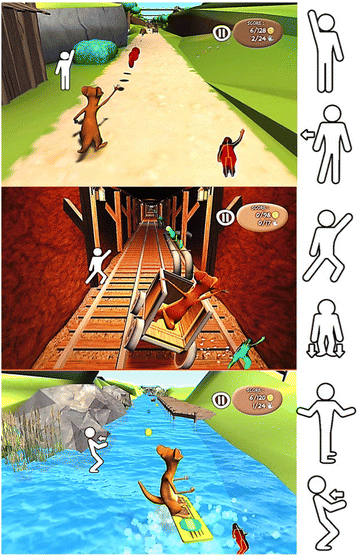The feasibility and positive effects of a customised videogame rehabilitation programme for freezing of gait and falls in Parkinson's disease patients: a pilot study
- PMID: 29636105
- PMCID: PMC5894136
- DOI: 10.1186/s12984-018-0375-x
The feasibility and positive effects of a customised videogame rehabilitation programme for freezing of gait and falls in Parkinson's disease patients: a pilot study
Abstract
Background: Freezing of gait and falls represent a major burden in patients with advanced forms of Parkinson's disease (PD). These axial motor signs are not fully alleviated by drug treatment or deep-brain stimulation. Recently, virtual reality has emerged as a rehabilitation option for these patients. In this pilot study, we aim to determine the feasibility and acceptability of rehabilitation with a customised videogame to treat gait and balance disorders in PD patients, and assess its effects on these disabling motor signs.
Methods: We developed a customised videogame displayed on a screen using the Kinect system. To play, the patient had to perform large amplitude and fast movements of all four limbs, pelvis and trunk, in response to visual and auditory cueing, to displace an avatar to collect coins and avoid obstacles to gain points. We tested ten patients with advanced forms of PD (median disease duration = 16.5 years) suffering from freezing of gait and/or falls (Hoehn&Yahr score ≥ 3) resistant to antiparkinsonian treatment and deep brain stimulation. Patients performed 18 training sessions during a 6-9 week period. We measured the feasibility and acceptability of our rehabilitation programme and its effects on parkinsonian disability, gait and balance disorders (with clinical scales and kinematics recordings), positive and negative affects, and quality of life, after the 9th and 18th training sessions and 3 months later.
Results: All patients completed the 18 training sessions with high feasibility, acceptability and satisfaction scores. After training, the freezing-of-gait questionnaire, gait-and-balance scale and axial score significantly decreased by 39, 38 and 41%, respectively, and the activity-balance confidence scale increased by 35%. Kinematic gait parameters also significantly improved with increased step length and gait velocity and decreased double-stance time. Three months after the final session, no significant change persisted except decreased axial score and increased step length and velocity.
Conclusions: This study suggests that rehabilitation with a customised videogame to treat gait and balance disorders is feasible, well accepted, and effective in parkinsonian patients. These data serve as preliminary evidence for further larger and controlled studies to propose this customised videogame rehabilitation programme at home.
Trial registration: ClinicalTrials.gov NCT02469350 .
Keywords: Falls; Freezing of gait; Parkinson’s disease; Rehabilitation; Videogame.
Conflict of interest statement
Authors’ information
DN is physiotherapist and PhD student; MV is physiotherapist; AVH is research engineer, specialized in kinematics data; CK is neurosurgeon, specialized in deep brain stimulation for movement disorders; PF is responsible of clinical research programme in the Genious Group; MLW is neurologist and neurophysiologist, specialized in movement disorders and gait and balance disorders.
Ethics approval and consent to participate
This study is part of clinical trial C15–12 sponsored by Inserm (ID RCB: 2015-A00277–42). It was granted approval by local Ethics Committee (Comité de protection des personnes-Ile de France V on June 2, 2015), authorised by the French authorities (ANSM, 150358B-31), and registered in a public trials registry (Trial Registration:
Competing interests
Dijana Nuic, Maria Vinti, Angele Van Hamme and Carine Karachi report no conflict of interest.
Marie-Laure Welter received personal fees from Medtronic for scientific board and medical training.
Pierre Foulon is employed by Genious Systems which has no property rights on the data.
Publisher’s Note
Springer Nature remains neutral with regard to jurisdictional claims in published maps and institutional affiliations.
Figures






Similar articles
-
Cueing training in the home improves gait-related mobility in Parkinson's disease: the RESCUE trial.J Neurol Neurosurg Psychiatry. 2007 Feb;78(2):134-40. doi: 10.1136/jnnp.200X.097923. J Neurol Neurosurg Psychiatry. 2007. PMID: 17229744 Free PMC article. Clinical Trial.
-
Do Patients With Parkinson's Disease With Freezing of Gait Respond Differently Than Those Without to Treadmill Training Augmented by Virtual Reality?Neurorehabil Neural Repair. 2020 May;34(5):440-449. doi: 10.1177/1545968320912756. Epub 2020 Mar 23. Neurorehabil Neural Repair. 2020. PMID: 32202203 Clinical Trial.
-
Force Platform-Based Intervention Program for Individuals Suffering with Neurodegenerative Diseases like Parkinson.Comput Math Methods Med. 2022 Jan 17;2022:1636263. doi: 10.1155/2022/1636263. eCollection 2022. Comput Math Methods Med. 2022. Retraction in: Comput Math Methods Med. 2023 Oct 18;2023:9860513. doi: 10.1155/2023/9860513. PMID: 35082910 Free PMC article. Retracted.
-
Motor learning in people with Parkinson's disease: Implications for fall prevention across the disease spectrum.Gait Posture. 2018 Mar;61:311-319. doi: 10.1016/j.gaitpost.2018.01.026. Epub 2018 Jan 31. Gait Posture. 2018. PMID: 29413803 Review.
-
Effects of Exercise on Falls, Balance, and Gait Ability in Parkinson's Disease: A Meta-analysis.Neurorehabil Neural Repair. 2016 Jul;30(6):512-27. doi: 10.1177/1545968315613447. Epub 2015 Oct 21. Neurorehabil Neural Repair. 2016. PMID: 26493731 Review.
Cited by
-
The activities of daily living partially mediate the relationship between rapid eye movement sleep behavior disorder and depressive symptoms in Parkinson's disease.Front Neurol. 2024 Jul 22;15:1357721. doi: 10.3389/fneur.2024.1357721. eCollection 2024. Front Neurol. 2024. PMID: 39131055 Free PMC article.
-
Effects of interactive video-game-based exercise on balance in older adults with mild-to-moderate Parkinson's disease.J Neuroeng Rehabil. 2020 Jul 13;17(1):91. doi: 10.1186/s12984-020-00725-y. J Neuroeng Rehabil. 2020. PMID: 32660512 Free PMC article. Clinical Trial.
-
Kinect-Based Assessment of Lower Limbs during Gait in Post-Stroke Hemiplegic Patients: A Narrative Review.Sensors (Basel). 2022 Jun 29;22(13):4910. doi: 10.3390/s22134910. Sensors (Basel). 2022. PMID: 35808426 Free PMC article. Review.
-
Use of a technology-based system to motivate older adults in performing physical activity: a feasibility study.BMC Geriatr. 2021 Jan 28;21(1):81. doi: 10.1186/s12877-021-02021-3. BMC Geriatr. 2021. PMID: 33509098 Free PMC article.
-
Chasing Protection in Parkinson's Disease: Does Exercise Reduce Risk and Progression?Front Aging Neurosci. 2020 Jun 19;12:186. doi: 10.3389/fnagi.2020.00186. eCollection 2020. Front Aging Neurosci. 2020. PMID: 32636740 Free PMC article. Review.
References
Publication types
MeSH terms
Associated data
LinkOut - more resources
Full Text Sources
Other Literature Sources
Medical

